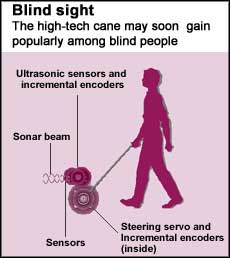Leading the blind
 people with visual impairment can now take help of a newly developed cane that would use sonar beams to guide them. Sonar is a system for detecting the position of objects by emmiting sound pulses. Johann Borenstein and Iwan Ulrich, mechanical engineers at the University of Michigan, usa , have designed this cane. The cane is similar in look to a traditional white cane but it has a semicircular black box on two wheels attached to its bottom end. Whenever the user pushes the cane along, a semicircular array of ultrasonic sensors projects a sonar beam in front to detect objects. In this course, the ultrasonic pulses bounce off obstacles up to 1.8 metres ahead and reflect back to sensors at the base of the cane (Discover , Vol 18, No 11).
people with visual impairment can now take help of a newly developed cane that would use sonar beams to guide them. Sonar is a system for detecting the position of objects by emmiting sound pulses. Johann Borenstein and Iwan Ulrich, mechanical engineers at the University of Michigan, usa , have designed this cane. The cane is similar in look to a traditional white cane but it has a semicircular black box on two wheels attached to its bottom end. Whenever the user pushes the cane along, a semicircular array of ultrasonic sensors projects a sonar beam in front to detect objects. In this course, the ultrasonic pulses bounce off obstacles up to 1.8 metres ahead and reflect back to sensors at the base of the cane (Discover , Vol 18, No 11).
Once the pulses reach the sensors, the wheels in the black box automatically turn and pass around the obstacle. It helps the user to feel the movement and follows along. Borenstein says that a person may soon become attuned to the movement of the cane and may start walking at about normal speed.
The weight of the device is nearly 3.6 kg. It resembles an upright vacuum cleaner. The device has steering motors for the two wheels, a small onboard computer to control the steering, and an array of ultrasonic sensors. The person sets the initial direction of travel with a thumb activated joystick on the cane's handle. When the user takes the cane along, the onboard computer changes the wheel positions to avoid meeting the obstacle. After crossing the obstacle, the cane returns to its original direction.
Even if the device is very useful for the visually impaired, it has many drawbacks too. The ultrasonic pulses can be deflected away from the sensors if they hit smooth surfaces such as glass doors. So the detection of the obstacle may not be easy for the device. Whereas some objects such as tables may exceed the reach of the sensors. But the researchers are optimistic that the sonar cane itself will be able to handle such situations in a few years. The device would cost nearly us $4,000.
Related Content
- Order of the National Green Tribunal regarding a waste management facility violating environmental norms, village Palej, district Bharuch, Gujarat, 07/03/2025
- Order of the Punjab and Haryana High Court regarding unauthorized constructions in areas of DLF City, Gurugram, Haryana, 13/02/2025
- Order of the High Court of Uttarakhand regarding mining operations in Bageshwar district, Uttarakhand, 06/01/2025
- Efficacy and Safety of Mycobacterium indicus pranii as an adjunct therapy in Category II pulmonary tuberculosis in a randomized trial
- Global report on diabetes
- Assessing the health impact of water quality interventions in low-income settings: Concerns associated with blinded trials and the need for objective outcomes
